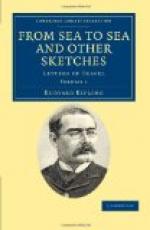Then the autumn sun rose, and the man smiled. Personally and politically he said he loathed the city—but it was his.
‘Well,’ he asked at last, ‘what do you think? Not so bad?’
‘Oh no. Not at all so bad,’ I answered; and it wasn’t till much later that I realised that we had exchanged the countersign which runs clear round the Empire.
A PEOPLE AT HOME
An up-country proverb says, ’She was bidden to the wedding and set down to grind corn.’ The same fate, reversed, overtook me on my little excursion. There is a crafty network of organisations of business men called Canadian Clubs. They catch people who look interesting, assemble their members during the mid-day lunch-hour, and, tying the victim to a steak, bid him discourse on anything that he thinks he knows. The idea might be copied elsewhere, since it takes men out of themselves to listen to matters not otherwise coming under their notice and, at the same time, does not hamper their work. It is safely short, too. The whole affair cannot exceed an hour, of which the lunch fills half. The Clubs print their speeches annually, and one gets cross-sections of many interesting questions—from practical forestry to State mints—all set out by experts.
Not being an expert, the experience, to me, was very like hard work. Till then I had thought speech-making was a sort of conversational whist, that any one could cut in at it. I perceive now that it is an Art of conventions remote from anything that comes out of an inkpot, and of colours hard to control. The Canadians seem to like listening to speeches, and, though this is by no means a national vice, they make good oratory on occasion. You know the old belief that the white man on brown, red, or black lands, will throw back in manner and instinct to the type originally bred there? Thus, a speech in the taal should carry the deep roll, the direct belly-appeal, the reiterated, cunning arguments, and the few simple metaphors of the prince of commercial orators, the Bantu. A New Zealander is said to speak from his diaphragm, hands clenched at the sides, as the old Maoris used. What we know of first-class Australian




